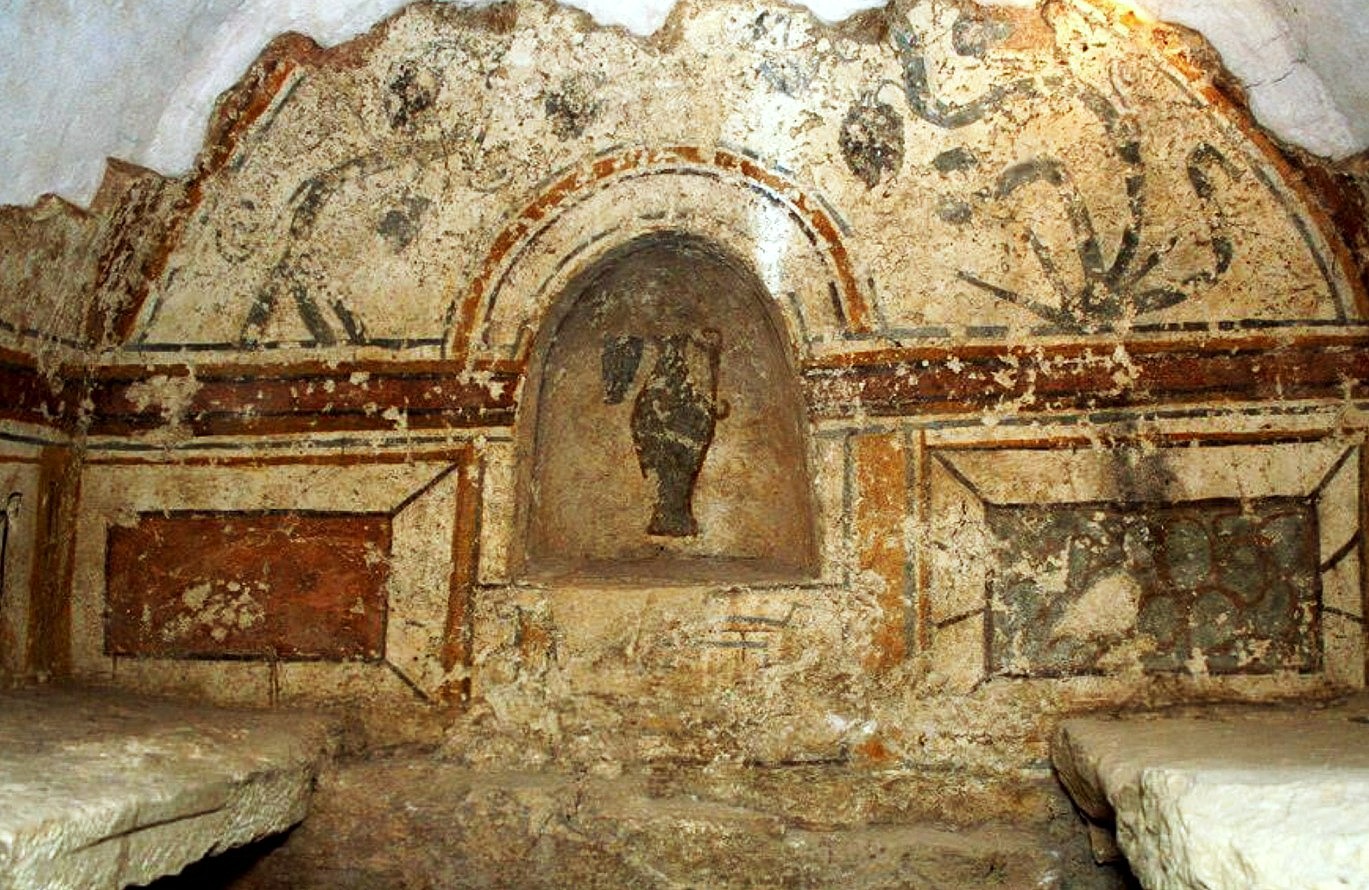The Romans established Pannonia in which their southern base was the city of Sopianae, today’s Pécs.
Early Christian burial sites in Europe are rarely intact and Pécs is important as having several examples from the 3rd and4th centuries that demonstrated how families previously and viciously persecuted for their religious beliefs, began planning and financing their burial rituals.

We stepped below street level within sight of the impressive St Peter’s cathedral to come face to face with the crypt of a Roman Christian burial chamber dated 275AD.
Vividly colourful frescoes of Adam and Eve and Daniel in the lion’s den decorated its sides and two short sarcophagi with lids intact occupied the interior. The sarcophagi were decorated with strange mask like faces, not out of place in a Venetian ball.

Throughout we saw the Christogram, a combination of the Greek letters X and P which is an abbreviation of the name Jesus Christ. It became the official symbol of Christianity in the fourth century and was also the symbol of the Roman state, meaning pagans used it to express loyalty to the ruling Empire.
Reeling, we went ventured above ground and a little further down the street to the Early Christian Mausoleum. Unique at the time of the Roman Empire the unfinished Septichora, a brick church of seven half crescent chapels, was the intended mausoleum of a dynastic family.
Underneath its floor we crept through burial chambers which included vivid frescoes of Saints Peter and Paul, one of the earliest known images of Mary, encapsulated in a blue robe, Jonah being devoured and then spat out by the whale and Noah in a small ark welcoming the white dove of peace. It was extraordinary.
Heading up to street level we lingered by a sarcophagus, the only one not to have been looted by grave robbers, where an elderly old boy had been entombed with a still-perfectly intact glass wine flagon. We mused on his funeral where possibly his family and friends had raised a final toast and donated to him the end of his favourite tipple, to accompany him on the way to heaven. Cheers old boy! Strength and honour.
St Peter’s Cathedral was first built in 1009 when Szent István, the country’s then King Stephan, ordered the united tribes of Hungary to build churches.
The cathedral, badly damaged by the Mongols, was rebuilt as a Gothic church in the 15th century. We learnt that the Mongols from the east utterly destroyed Hungary, killing half of the population in 1241 in their push west.
Outside the cathedral, on gates to the university complex, a very 20th century declaration of love apparently began here. When you see engraved padlocks attached to famous monuments and structures around the world, blame the Pécs student who accidentally started the trend in the 1970s.

Back in the town centre and Pécs is a story book of Hungary’s history. Pride of place in its glorious Secession-lined square of theatrical and government buildings, the Turkish mosque of Gazi Kasim Pasha dominates the skyline.
It was the largest Mosque in Hungary and remains its most important Turkish monument. In the dramatic twists of Hungary’s history, the Ottoman Empire was routed from the country and surrendered all of its possessions (in Hungary) to the Habsburg Empire in 1699, after which the Mosque then reverted back to a Catholic church.

A striking exhibition of pottery in the revitalised workshops and blast furnaces of Hungary’s Zsolnay family amazed us. Who could have thought a couple of pots and a few plates would hold such significance?
The Zsolnay family of clay-throwers and painters rose with the tide of Secession to create extraordinary and still thoroughly modern-looking china dinner sets, vases and ornaments, coveted the world over.
I loved a ‘card holder’ from 1900 featuring a neon green mermaid hideously startled by a sea snake. Do you really want to extend a welcome to this particular caller?
In a town of mausoleums, and famous in their own lifetime, the Zsolnays did not skimp on their own resting place. A little way from their workshops, and upon on a bluff, 42 paprika-red lions crouch alongside a brick pathway that leads up to their tomb.
Secession in Europe, also known as Art Nouveau, was a quest for a new way of defining living spaces. It used elaborate ironwork, ceramic tiles and bright colours to decorate linear buildings. Later architects created curved, bulbous and organic buildings, good examples of which we had seen in nearby Serbia at Subotica.
A fitting tribute to the Zsolnay family was the bulls’ head fountain, featuring their trademark Majollica blue glaze, now faded, and fabulous green and gold gilt glazed bulls’ heads.

We found an edgier side to the city on a hot walk east to our campsite. Grimy looking apartments with dirty balconies draped in washing lined the road.
Grimy looking people ambled around or simply sat and smoked in the heat of the late afternoon. Young girls in too short shorts strolled by and older women swept doorways.
It was an age from the splendour of Rome and the Secession success of the Zsolnays. It caused us to reflect more upon what we were increasingly learning about Hungary today. The commonly held view is that the wealth is in the north, in and around Budapest, and the rest of the country survives by the capital’s heartbeat. We were keen to find out more.





























